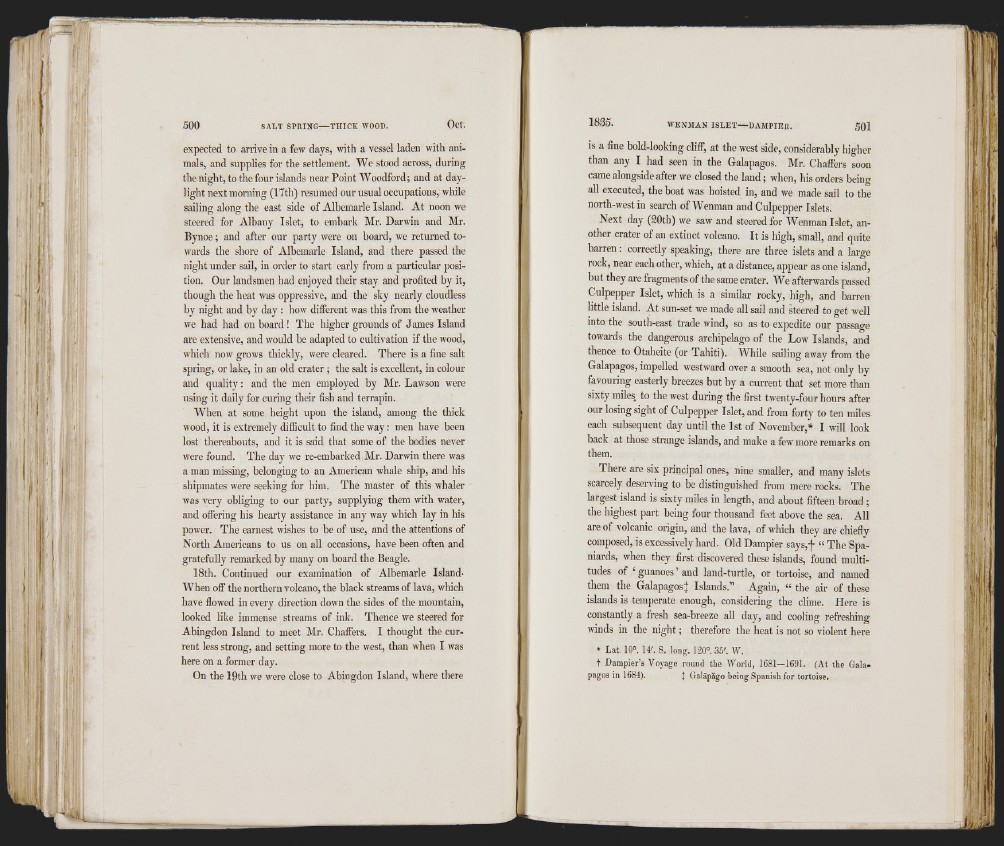
500 SALT SPRING THICK WOOD. Oct.
I’ /:
iri .
111 I'i
ii' Í : 1
expected to arrive in a few days, with a vessel laden with animals,
and supplies for the settlement. We stood across, during
the night, to the four islands near Point Woodford; and at daylight
next morning (17th) resumed our usual occupations, while
sailing along the east side of Albemarle Island. At noon we
steered for Albany Islet, to embark Mr. Darwin and Mr.
Bynoe; and after our party were on board, we returned towards
the shore of Albemarle Island, and there passed the
night under sail, in order to start early from a particular position.
Our landsmen had enjoyed their stay and profited by it,
though the heat was oppressive, and the sky nearly cloudless
by night and by day : how different was this from the weather
we had had on board ! The higher grounds of James Island
are extensive, and would be adapted to cultivation if the wood,
which now grows thickly, were cleared. There is a fine salt
spring, or lake, in an old crater ; the salt is excellent, in colour
and quality: and the men employed by Mr. Lawson were
using it daily for curing their fish and terrapin.
When at some height upon the island, among the thick
wood, it is extremely difficult to find the way; men have been
lost thereabouts, and it is said that some of the bodies never
were found. The day we re-embarked Mr. Darwin there was
a man missing, belonging to an American whale ship, and his
shipmates were seeking for him. The master of this whaler
was very obliging to our party, supplying them with water,
and offering his hearty assistance in any way which lay in his
power. The earnest wishes to be of use, and the attentions of
North Americans to us on all occasions, have been often and
gratefully remarked by many on board the Beagle.
18th. Continued our examination of Albemarle Island-
When off the northern volcano, the black streams of lava, which
have flowed in every direction down the sides of the mountain,
looked like immense streams of ink. Thence we steered for
Abingdon Island to meet Mr. Chaffers. I thought the current
less strong, and setting more to the west, than when I was
here on a former day.
On the 19th we were close to Abingdon Island, where there
is a fine bold-looking cliff, at the west side, considerably higher
than any I had seen in the Galapagos. Mr. Chaffers soon
came alongside after we closed the land; when, his orders being
all executed, the boat was hoisted in, and we made sail to the
north-west in search of Wenman and Culpepper Islets.
Next day (20th) we saw and steered for Wenman Islet, another
crater of an extinct volcano. I t is high, small, and quite
barren: correctly speaking, there are three islets and a large
rock, near each other, which, at a distance, appear as one island,
but they are fragments of the same crater. We afterwards passed
Culpepper Islet, which is a similar rocky, high, and barren
little island. At sun-set we made all sail and steered to get well
into the south-east trade wind, so as to expedite our passage
towards the dangerous archipelago of the Low Islands, and
thence to Otaheite (or Tahiti). While sailing away from the
Galapagos, impelled westward over a smooth sea, not only by
favouring easterly breezes but by a current that set more than
sixty miles, to the west during the first twenty-four hours after
our losing sight of Culpepper Islet, and from forty to ten miles
each subsequent day until the 1 st of November,* I will look
back at those strange islands, and make a few more remarks on
them.
There are six principal ones, nine smaller, and many islets
scarcely deserving to be distinguished from mere rocks. The
largest island is sixty miles in length, and about fifteen broad ;
the highest part being four thousand feet above the sea. All
are of volcanic origin, and the lava, of which they are chiefly
composed, is excessively hard. Old Dampier says,f “ The Spaniards,
when they first discovered these islands, found multitudes
of ‘ guanoes’ and land-tnrtle, or tortoise, and named
them the Galapagos] Islands.” Again, “ the air of these
islands is temperate enough, considering the clime. Here is
constantly a fresh sea-breeze all day, and cooling refreshing
winds in the night; therefore the heat is not so violent here
* Lat. 10°. 14'. S. long. 120°. 35'. W.
t Dampier’s Voyage round the World, 1681—1691. (At the Gala-
pagos in 1684). J Galápago being Spanish for tortoise.
S !
jli I
■f